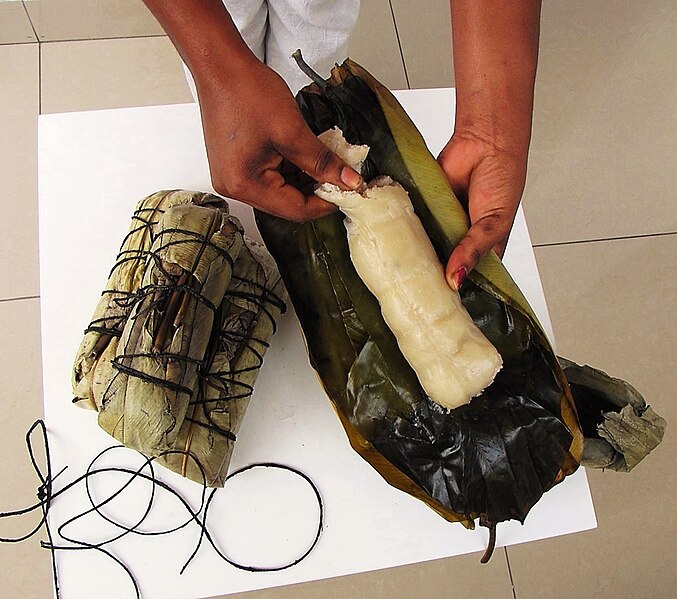File:Cassava Bread - cassava cooked in leaf wrap (Kwanga, Chikwangue).jpg
Iš Wikimedia Commons.
Pereiti į navigaciją
Jump to search

Šios peržiūros dydis: 677 × 599 taškų. Kitos 3 rezoliucijos: 271 × 240 taškų | 542 × 480 taškų | 924 × 818 taškų.
Pradinė rinkmena (924 × 818 taškų, rinkmenos dydis: 223 KiB, MIME tipas: image/jpeg)
File information
Structured data
Captions
Captions
Add a one-line explanation of what this file represents
Aprašymas
[keisti]| AprašymasCassava Bread - cassava cooked in leaf wrap (Kwanga, Chikwangue).jpg |
English: A stack of fully-cooked, leaf-wrapped packets as sold on the street, also with the leaves unwrapped to show the ready-to-eat cassava 'bread.' If kept in the cooked leaf wrap, it is quite hygienic and will usually stay fresh for several days. Can be eaten as-is, but usually pinched off and dipped in any popular sauce. In the Congo (DRC) and central African region, often called kwanga or chikwangue, but also known by many names in the various languages across the region. Not actually a bread but a thick paste of soaked, rinsed and pounded cassava that is steamed-cooked inside leaves. Leaves also add a bit of tangy flavor during the cooking process. Six large leaves were used to tightly fold around and seal the roll of cassava before tied and cooked. Leaves shown from the plant Sarcophrynium arnoldium (Megaphrynium macrostachyum), alternately banana leaves can be used if these are not available.
Português: Uma pilha de pacotes embrulhados em folhas, totalmente cozidos, vendidos na rua, também com as folhas desembrulhadas para mostrar o 'pão' de mandioca pronto para comer. Se mantido no envoltório de folhas cozidas, é bastante higiênico e geralmente permanece fresco por vários dias. Pode ser comido no estado em que se encontra, mas geralmente retirado e mergulhado em qualquer molho popular. No Congo (RDC) e na região da África Central, costuma ser chamado de kwanga ou chikwangue, mas também conhecido por muitos nomes nas várias línguas da região. Não é realmente um pão, mas uma pasta espessa de mandioca embebida, enxaguada e amassada que é cozida no vapor dentro das folhas. As folhas também adicionam um pouco de sabor picante durante o processo de cozimento. Seis folhas grandes foram usadas para dobrar firmemente e selar o rolo de mandioca antes de amarrado e cozido. Folhas mostradas da planta Sarcophrynium arnoldium (Megaphrynium macrostachyum), alternativamente folhas de bananeira podem ser usadas se estas não estiverem disponíveis. |
| Data | |
| Šaltinis | Mano darbas |
| Autorius | T.K. Naliaka |
Licencija
[keisti]Aš, šio darbo autoriaus teisių savininkas, publikuoju jį su šia licencija:
This file is licensed under the Creative Commons Attribution-Share Alike 4.0 International license.
- Jūs galite:
- dalintis – kopijuoti, platinti bei persiųsti šį darbą
- pri(si)taikyti – adaptuoti darbą
- Su šiomis sąlygomis:
- autoriaus nurodymas – Turite pateikti atitinkamą kreditą, pateikti nuorodą į licenciją ir nurodyti, ar buvo atlikti pakeitimai. Tai galite padaryti bet kokiu būdu, bet ne taip, kad licencijos išdavėjas patvirtintų jus ar jūsų naudojimą.
- dalinkis panašiai – Jei perdirbsite, redaguosite ar atkursite šį darbą, jį galėsite platinti tik su tokia pačia ar panašia į šią licencija.
Rinkmenos istorija
Paspauskite ant datos/laiko, kad pamatytumėte rinkmeną tokią, kokia ji buvo tuo metu.
| Data/Laikas | Miniatiūra | Matmenys | Naudotojas | Paaiškinimas | |
|---|---|---|---|---|---|
| dabartinis | 21:45, 17 rugsėjo 2015 |  | 924 × 818 (223 KiB) | Piki-photow (aptarimas | indėlis) | User created page with UploadWizard |
Jūs negalite perrašyti šios rinkmenos.
Rinkmenos naudojimas
Šie puslapiai naudoja šią rinkmeną:
- File:Cassava Bread - cassava cooked in leaf wrap (Kwanga, Chikwange).jpg (failo peradresavimas)
- File:Cassava Bread - cassava cooked in leaf wrap (Kwanga, Shikwange).jpg (failo peradresavimas)
Visuotinis rinkmenos naudojimas
Ši rinkmena naudojama šiose viki svetainėse:
- Naudojama en.wikipedia.org
- Naudojama es.wikipedia.org
- Naudojama fr.wikipedia.org
- Naudojama it.wikipedia.org
- Naudojama lt.wikipedia.org